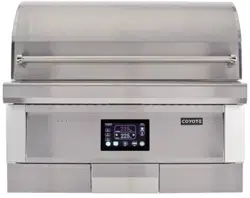Loading ...
Loading ...
Loading ...

8
Check your local building codes for the proper method of installation. If an external electrical source is utilized,
this outdoor cooking appliance, when installed, must be electrically grounded in accordance with local codes.
In the absence of local codes, this unit should be installed in accordance with the National Electrical Code
ANSI/NFPA No. 70 or the Canadian Electrical Code CSA C22.1, 1990 or latest version.
Before installing built-in grills in enclosures, copy all product information such as model number, serial
number and store information in a safe place.
If the grill is installed by a professional installer or technician, be sure that he or she shows you where your
electrical supply shut-off is located.
Notice: We strongly recommend professional installation of your Coyote grill. These instructions provide the
measurements necessary to construct a masonry structure to house your outdoor pellet grill.
LOCATION OF YOUR GRILL:
Locate the grill only OUTSIDE in a well-ventilated area. Never locate the grill in a building, garage, breezeway,
shed or other such enclosed areas without an approved ventilation system. When in use, the grill will
generate a lot of smoke. When installing your grill, select an outdoor location that will ensure there is adequate
area for the smoke to dissipate IN ORDER TO AVOID INHALATION OF POTENTIALLY TOXIC FUMES.
Ventilation Requirements for Proper Operation of your Coyote Grill
Ventilation for a pellet grill is absolutely mandatory to ensure that your grill performs as intended and
to ensure the safety of you, your family, and guests. Proper ventilation is necessary to allow heat
inside your grill to escape.
Failure to provide proper ventilation will nullify Coyote’s warranty and will cause a risk of bodily injury
or death.
If you elect to install your grill into an island, the island itself must be ventilated properly. Any such
island must have a minimum of 2 vents (but optimally 4 vents) per cabinet. Each vent must be at least
20 sq. in in size and have access to outside/fresh air. Those vents will allow heat that is trapped inside
due to wind to be able to dissipate out of the island vents. However, if the island is not ventilated
properly and the wind is coming from the back, then the heat will try to escape through the easiest
exit, which will most likely be through the bottom of the grill and front control panel.
A simple way to think of what is occurring inside your grill is that when your burners are on, they are
emitting a flame that creates the heat to cook your food. This heat must exhaust or escape from the
grill, otherwise you would eventually have a unit that would not only build up intense heat but also
dangerous pressure. This could cause severe damage to not only the grill but any operators or people
or property near-by. The grill itself allows for ventilation mainly through the rear of the unit above the
rear panel but below the top of the hood. However, wind can act as a barrier to ventilation and
exhaust. This blockage of exhaust can cause problems and hazardous conditions. Therefore, great care
must be taken in selecting a location for your grill and in the installation of it into any masonry island
or other outdoor structure. This can cause the control panel to get hot to the touch and possibly even
burn your fingers.
Ventilation and typical wind direction and conditions must always be considered when planning your
Locating the Grill
Loading ...
Loading ...
Loading ...
